Related Research Articles

According to the Hebrew Bible, the Kingdom of Israel, was one of two successor states to the former United Kingdom of Israel and Judah. Historians often refer to the Kingdom of Israel as the "Northern Kingdom" or as the "Kingdom of Samaria" to differentiate it from the Southern Kingdom of Judah.
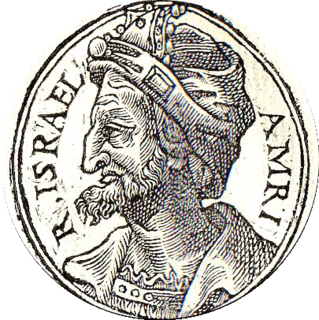
Omri was, according to the Hebrew Bible, the sixth king of Israel. He was a successful military campaigner who extended the northern kingdom of Israel. Other monarchs from the House of Omri are Ahab, Ahaziah, Joram, and Athaliah. Like his predecessor, king Zimri, who ruled for only seven days, Omri is the second king mentioned in the Bible without a statement of his tribal origin. One possibility, though unproven, is that he was of the tribe of Issachar.
The 8th century BC started the first day of 800 BC and ended the last day of 701 BC. The 8th century BC is a period of great change for several historically significant civilizations. In Egypt, the 23rd and 24th dynasties lead to rule from Nubia in the 25th Dynasty. The Neo-Assyrian Empire reaches the peak of its power, conquering the Kingdom of Israel as well as nearby countries.
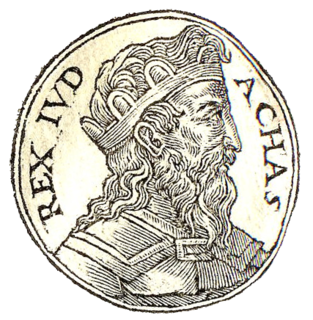
Ahaz an abbreviation of Jehoahaz II, "Yahweh has held" was the twelfth king of Judah, and the son and successor of Jotham. Ahaz was 20 when he became king of Judah and reigned for 16 years.

Tiglath-Pileser III was a prominent king of Assyria in the eighth century BCE who introduced advanced civil, military, and political systems into the Neo-Assyrian Empire.
Shalmaneser is documented by The Bible as an Assyrian king, identified with Shalmaneser II (by Archibald Sayce) or IV, the successor of Pul on the throne of Assyria. He made war against Hoshea, the king of Israel, whom he subdued and compelled to pay an annual tribute. Hoshea, however, soon after rebelled against his Assyrian conqueror. Shalmaneser again marched against Samaria, which, after a siege of three years, was taken by Sargon. A revolution meantime had broken out in Assyria, and Shalmaneser was deposed. Sargon usurped the vacant throne. Eberhard Schrader thought that this is probably the name of a king of Moab mentioned on an inscription of Tiglath-Pileser III as Salamanu.
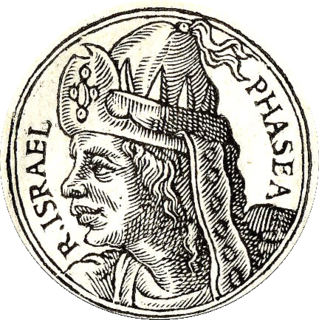
Pekah was the eighteenth and penultimate king of Israel. He was a captain in the army of king Pekahiah of Israel, whom he killed to become king. Pekah was the son of Remaliah.

Shalmaneser V was king of Assyria and Babylon from 727 to 722 BCE. He first appears as governor of Zimirra in Phoenicia in the reign of his father, Tiglath-Pileser III. Evidence pertaining to his reign is scarce.
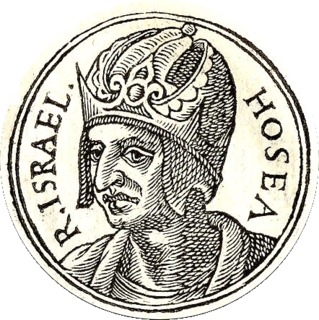
Hoshea was the nineteenth and last king of the Israelite Kingdom of Israel and son of Elah. William F. Albright dated his reign to 732–721 BC, while E. R. Thiele offered the dates 732–723 BC.
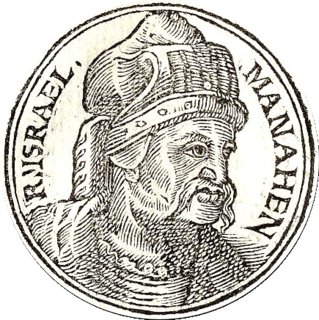
Menahem or Menachem was the sixteenth king of the northern Israelite Kingdom of Israel. He was the son of Gadi, and the founder of the dynasty known as the House of Gadi or House of Menahem. Some have speculated that Gadi was a scion of the tribe of Gad.

Jotham or Yotam was the eleventh king of Judah, and son of King Uzziah and Jerusha, daughter of Zadok. Jotham was 25 when he began his reign, and reigned for 16 years. Edwin R. Thiele concluded that his reign commenced as a coregency with his father, which lasted for 11 years. Because his father Uzziah was afflicted with tzaraath after he entered the Temple to burn incense, Jotham became governor of the palace and the land at that time, i.e. coregent, while his father lived in a separate house as a leper.
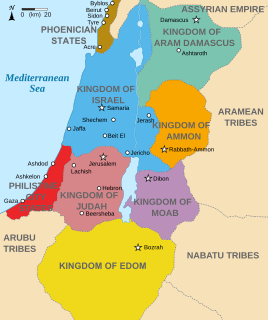
Aram-Damascus was an Aramean state around Damascus in Syria, from the late 12th century BC to 732 BC.
The Syro-Ephraimite War took place in the 8th century BC, when the Neo-Assyrian Empire was a great regional power. The tributary nations of Aram-Damascus and the Kingdom of Israel decided to break away. The Kingdom of Judah, ruled by King Ahaz, refused to join the coalition. In 735 BC Aram-Damascus, under Rezin, and Israel, under Pekah, attempted to depose Ahaz through an invasion. Judah was being defeated and, according to 2 Chronicles, lost 120,000 troops in just one day. Many significant officials were killed, including the king's son. Many others were taken away as slaves. Telling of the same war, 2 Kings 16:5 states that Rezin and Pekah besieged Jerusalem but failed to capture it.
King Rezin of Aram or Rasin of Syria in DRB ruled from Damascus during the 8th century BC. During his reign, he was a tributary of King Tiglath-Pileser III of Assyria.

The Assyrian captivity is the period in the history of Ancient Israel and Judah during which several thousand Israelites of ancient Samaria were resettled as captives by Assyria. This is one of the many instances of forcible relocations implemented by the Neo-Assyrian Empire. The Northern Kingdom of Israel was conquered by the Neo-Assyrian monarchs, Tiglath-Pileser III (Pul) and Shalmaneser V. The later Assyrian rulers Sargon II and his son and successor, Sennacherib, were responsible for finishing the twenty-year demise of Israel's northern ten-tribe kingdom, although they did not overtake the Southern Kingdom. Jerusalem was besieged, but not taken. The tribes forcibly resettled by Assyria later became known as the Ten Lost Tribes.

2 Kings 16 is the sixteenth chapter of the second part of the Books of Kings in the Hebrew Bible or the Second Book of Kings in the Old Testament of the Christian Bible. The book is a compilation of various annals recording the acts of the kings of Israel and Judah by a Deuteronomic compiler in the seventh century BCE, with a supplement added in the sixth century BCE. This chapter records the events during the reign of Ahaz, the king of Judah.

2 Kings 18 is the eighteenth chapter of the second part of the Books of Kings in the Hebrew Bible or the Second Book of Kings in the Old Testament of the Christian Bible. The book is a compilation of various annals recording the acts of the kings of Israel and Judah by a Deuteronomic compiler in the seventh century BCE, with a supplement added in the sixth century BCE. This chapter records the events during the reign of Hezekiah, the king of Judah, a part of the section comprising 2 Kings 18:1 20:21, with a parallel version in Isaiah 36–39.

2 Kings 15 is the fifteenth chapter of the second part of the Books of Kings in the Hebrew Bible or the Second Book of Kings in the Old Testament of the Christian Bible. The book is a compilation of various annals recording the acts of the kings of Israel and Judah by a Deuteronomic compiler in the seventh century BCE, with a supplement added in the sixth century BCE. This chapter records the events during the reigns of Azariah (Uzziah) and his son, Jotham, the kings of Judah, as well as of Zechariah, Shallum, Menahem, Pekahiah and Pekah, the kings of Israel. Twelve first verses of the narrative belong to a major section 2 Kings 9:1–15:12 covering the period of Jehu's dynasty.

2 Kings 17 is the seventeenth chapter of the second part of the Books of Kings in the Hebrew Bible or the Second Book of Kings in the Old Testament of the Christian Bible. The book is a compilation of various annals recording the acts of the kings of Israel and Judah by a Deuteronomic compiler in the seventh century BCE, with a supplement added in the sixth century BCE. This chapter records the events during the reigns of Hoshea the last king of Israel, the capture of Samaria and the deportation of the northern kingdom population by the Assyrian.
The House of Pekah or dynasty of Pekah was a reigning dynasty of the Kingdom of Israel. It is represented by a single king, Pekah. The reign of this dynasty is covered in 2 Kings, 15:27-31 and 16:5-7.